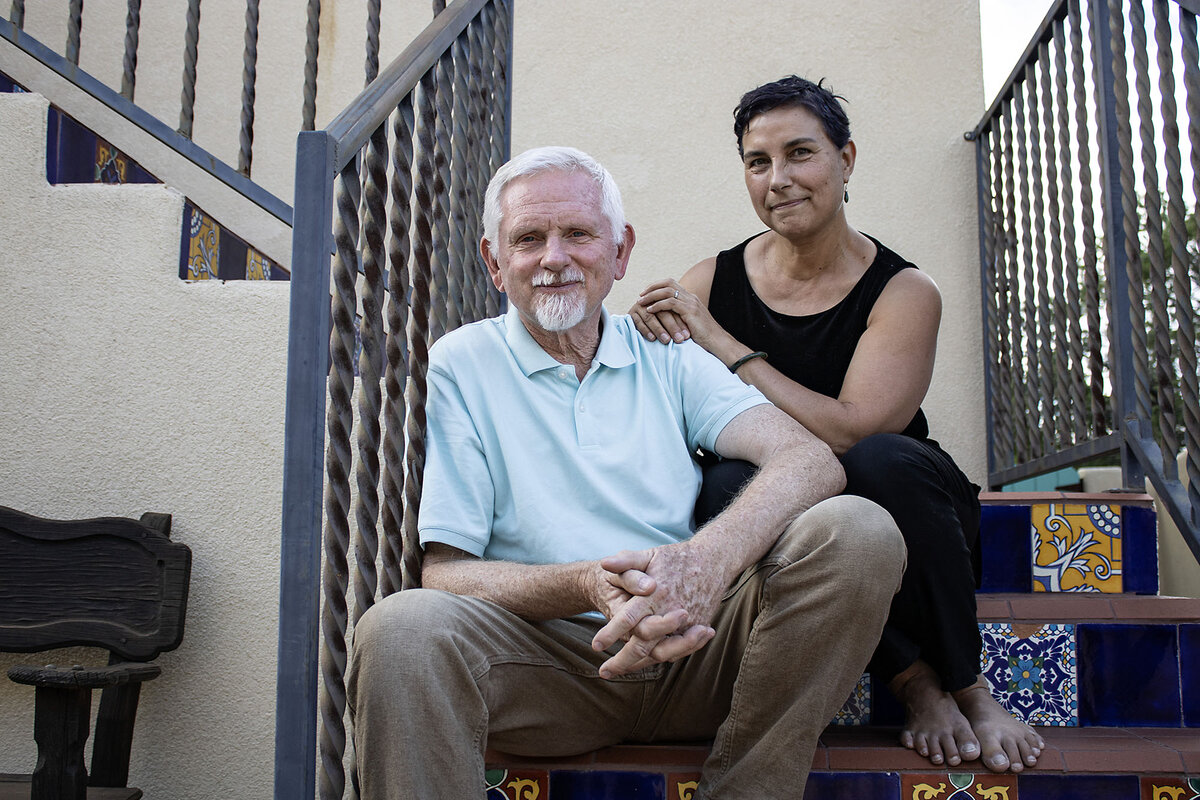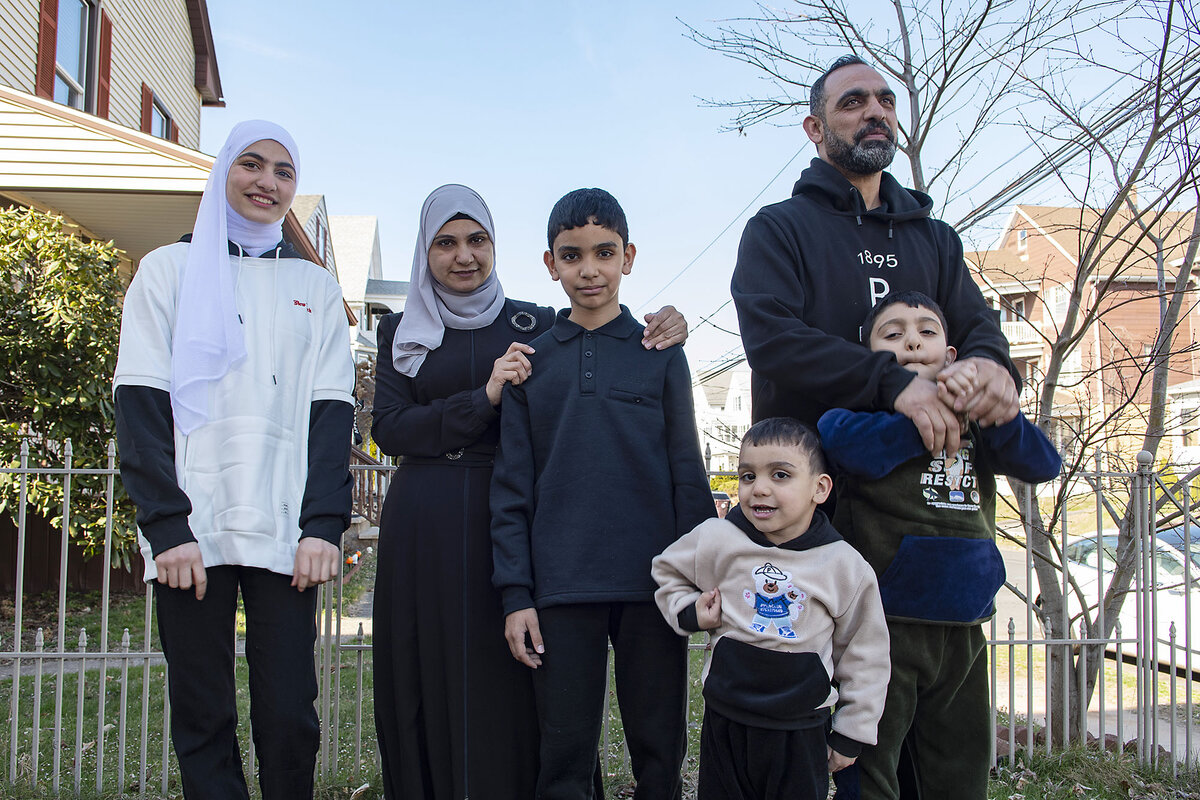Biden vowed to revive US refugee program. Everyday Americans are helping.
Loading...
| TRINIDAD, COLO.
Mohammed Humed spent 16 years in a refugee camp. That’s almost half his life so far.
The Eritrean fled his East African home in 2008, fearing threats from a repressive government that detained his family members. At a refugee camp in neighboring Ethiopia, unable to work, he says meals weren’t guaranteed.
Now, in southern Colorado, a group of American strangers has found Mr. Humed a home. They’ve also found him a job. And a griddle for injera flatbread. All this came through a new program called Welcome Corps that allows private citizens to sponsor refugees.
Why We Wrote This
A story focused onWelcoming refugees has long been an American tradition. Resettlement has rebounded under the Biden administration, with American citizens lending a hand.
In July, these Colorado volunteers, with the backing of the U.S. State Department, brought Mr. Humed and his family to their mountain-flanked town of Trinidad. The roughly 11,000 residents are mostly white. And no one else here speaks Afar, his native language, says Mr. Humed. Still, he’s grateful enough for the warm welcome to stay for now – with the hope of one day bringing more people like him here.
“Welcome Corps is my second family,” Mr. Humed says through an interpreter. He calls one of his sponsors “like my father.”
That sponsor, Tim Crisler, is also moved. The retiree doesn’t have children and has enjoyed this new fatherly role.
“It’s been very profound for me,” Mr. Crisler says at his home, where he sits across from Mr. Humed. “I feel like – OK, I’ve had some purpose in life.”
Launched last year, Welcome Corps counts on the generosity of everyday Americans to financially – and logistically – support refugees for their first 90 days in the country. It’s part of an effort by the Biden administration to expand refugee admissions at a time of historic displacement globally, and to promote neighborliness toward newcomers.
Welcome Corps arrivals – 919 so far, with more arriving each week – are modest compared with the more than 84,000 refugees admitted to the country this fiscal year. Still, they represent an expansion of the nation’s refugee admissions program, which is on track to reach a three-decade high. Donald Trump downsized the refugee program while president and has pledged to suspend refugee resettlement if reelected.
Though the future of Welcome Corps remains unclear past the November presidential election, a State Department spokesperson reports that more than 100,000 people have applied to sponsor refugees through this opportunity.
Meanwhile, more than a dozen interviews with participants and program leaders point to a common theme: Improving Welcome Corps means balancing an outpouring of help with the right kind of help – as some efforts may result in unintended hardships for refugees.
As a former private sponsor, Erin Schutte Wadzinski in Minnesota knows that challenge firsthand.
Just as sponsors and their communities benefit from welcoming refugees, she says, “My hope is that refugees, too, find satisfaction in this model.”
U.S. refugee program under Trump, then Biden
Refugees, who are those fleeing persecution or have a well-founded fear of persecution, can eventually apply for U.S. citizenship.
Unlike asylum-seekers, refugees apply for protection while still outside the United States, and undergo intensive vetting before their arrival. Refugees are typically resettled by a core group of nonprofits with offices across the country. But those sites, often in sizable cities, have a 100-mile service radius.
Overseen by the State Department, the U.S. Refugee Admissions Program is a bipartisan creation of Congress.
“Ever since the passage of the Refugee Act of 1980, there’s been a great interest on the part of the federal government in helping refugees,” says Alan Kraut, distinguished professor of history at American University.
While in office, Mr. Trump lowered the country’s annual cap on refugee admissions to historic lows, citing a need to devote more resources to the southern border. He dropped the ceiling for refugee admissions by over 80% – from 85,000 in fiscal year 2016 under President Barack Obama, to 15,000 in fiscal year 2021, a record low. That caused some resettlement agencies to downsize. The pandemic further restricted resettlement efforts.
The next president, Joe Biden, pledged not just to rebuild, but to expand. In his second month in office, Mr. Biden signed an executive order urging the country to “innovate” on refugee resettlement, and referenced private sponsorship to explore. He raised Mr. Trump’s final cap and, for fiscal year 2022 onward, set the refugee admissions cap at 125,000, a figure his administration has so far been unable to meet.
In designing Welcome Corps, the U.S. drew on lessons from Canada, where just over half of its 51,080 refugees admitted last year came through private sponsorship.
The State Department announced Welcome Corps in January 2023, allowing groups of five or more Americans or permanent residents to sponsor refugees. This way, sponsors take over the reins of resettlement from nonprofits, but still undergo vetting, training, fundraising targets, and oversight from organizations with resettlement experience.
“At a time when people feel so divided or isolated from their neighbors, sponsorship really helps foster that collaboration across communities,” says Sarah Cross, deputy assistant secretary at the Bureau of Population, Refugees, and Migration, which is part of the State Department.
Some analysts view Welcome Corps skeptically. Private funding alleviates some of the burden on American taxpayers, as sponsors are required to secure at least $2,425 in funds for each refugee, says Ira Mehlman, spokesperson for the Federation for American Immigration Reform. But he questions the extent of the savings.
“What happens after the $2,000 per head that they raise runs out, which, you know, is likely to be within a very short time frame?” he says. “Who then picks up the cost at that point?”
The program is meant as an on-ramp to self-sufficiency, advocates say. The federal government reports that refugees are a net benefit to the economy, at least measured over a 15-year period.
“Acts of compassion” from volunteers
Welcome Corps is in its early stages. But the State Department expects it to become an “enduring and foundational piece” of the U.S. Refugee Admissions Program over time, says Ms. Cross.
Supporters cite the abundance of goodwill, from volunteers who want to help, as one of the program’s core strengths.
“Those acts of compassion are, I think, what motivate us every day,” says Maggie Mitchell Salem, executive director of Integrated Refugee & Immigrant Services in Connecticut. “Welcome Corps is the Peace Corps of refugee resettlement.”
Other strengths include placing refugee families in new areas, says Una Bilic, deputy director of new resettlement pathways at the International Rescue Committee, a nonprofit working with Welcome Corps. Refugee caseworkers often have more clients than they can manage well, without the time and individual attention that a private sponsor group can dedicate, says Ms. Bilic, a former refugee from Bosnia.
Yet from the start, some resettlement experts were skeptical of Welcome Corps. They worried that well-meaning but inexperienced volunteers might be overwhelmed, with refugees left to suffer. Researchers at Stanford University, currently studying a co-sponsorship model that predates Welcome Corps, report mixed results around incorporating private citizens into resettlement.
“These relationships do have their own kind of power dynamics, because the families are dependent on the volunteers for accessing resources,” says Pei Palmgren, a postdoctoral fellow with Stanford University’s Immigration Policy Lab. “I think that’s a big worry as well for the Welcome Corps,” he adds, especially if there’s limited oversight.
Private sponsors aren’t resettlement experts – especially when faced with complex tasks such as applying for a refugee’s public benefits. That’s why the International Rescue Committee, which is part of a coalition of groups administering Welcome Corps, launched a “support line” for sponsors in March. And as volunteers scramble to find refugees affordable housing amid a nationwide crunch, Airbnb.org has offered housing-support grants.
Making the match
Ms. Schutte Wadzinski lives in farm country in Worthington, Minnesota. Her private sponsor group greeted the first Welcome Corps arrivals in June 2023 – a family of five from Tanzania and the Democratic Republic of Congo.
As an immigration lawyer, Ms. Schutte Wadzinski says even she was surprised by challenges posed by tracking official paperwork. Delays in the processing of documents, for instance, complicated the refugee family’s access to public benefits.
“We all came away from it having gained more than we would have anticipated,” she says. “But also it was more work, perhaps, than many of us anticipated.”
The biggest issues for the refugees her group sponsored appeared to be cultural and linguistic isolation. Language expertise that Ms. Schutte Wadzinski says was highlighted in her group’s sponsorship application – such as the East African languages of Amharic and Tigrinya – wasn’t reflected in its match.
The Community Sponsorship Hub, which leads Welcome Corps operations, acknowledges the challenge. The nonprofit has seen “a lot of improvement” in matching, as more certified sponsors mean more options for refugees, says Annie Nolte-Henning, the executive director.
While not common, some Welcome Corps refugees have chosen to move away from their original destination within the first 90 days, she says. Refugees risk losing access to sponsors’ resources, and potentially public benefits, if they do.
Ms. Nolte-Henning notes that “out-migration” has been a normal feature of refugee resettlement for decades. And instead of a failure, she sees those moves as a “success – that a family found agency to make a choice.”
Zyad Al Mahameed made that choice. The Syrian refugee and his family first settled in Connecticut in March, through Welcome Corps. They then traveled to Canada several months later to be closer to the comfort of family there. The father says they hope to stay.
The decision was “mostly for my children. They felt very isolated,” says Mr. Al Mahameed in Arabic through an interpreter. “Welcome Corps helped us a lot – they weren’t the reason why we left,” he clarifies, though he wishes he had been enrolled in English classes.
Welcome Corps creates new pathways
Welcome Corps is now expanding with opportunities for U.S. employers and higher education institutions. The latter, Welcome Corps on Campus, with more than a dozen U.S. colleges and universities on board so far, recently announced the arrival of more than 30 refugee students for the start of fall semester. Welcome Corps also now allows volunteers to name whom they want to sponsor, such as family members still abroad.
That’s what Bashar Ahmed Aldulymi did. And after years of anguished waiting, the Texan greeted his Iraqi brother at an airport last month, wrapping him in an American flag.
Mr. Ahmed Aldulymi fled Iraq in 2008, five years after the American invasion. Now a U.S. citizen, he says he’s tried for over a decade to bring over Iraqi family members displaced in Turkey.
He watched as the Trump administration curbed refugee admissions and announced what some called a Muslim ban. Then he watched Americans roll out the welcome mat for displaced Afghans in 2021 and Ukrainians in 2022.
An avid news reader, Mr. Ahmed Aldulymi remembers the exact date of the Welcome Corps launch: Jan. 19, 2023. The hopeful sponsor of his family dove into learning and application mode. Meanwhile, his older brother, who’d waited for years in Turkey, died.
While sponsorship is a huge responsibility, says Mr. Ahmed Aldulymi, he recommends it. The relief of reunion came last month when he welcomed his younger brother’s family to Texas.
Welcome Corps “gave me access to my family,” says Mr. Ahmed Aldulymi.
Abdulrahman Ismail contributed Afar interpretation, and Yasmeen Othman contributed Arabic interpretation for this story.










